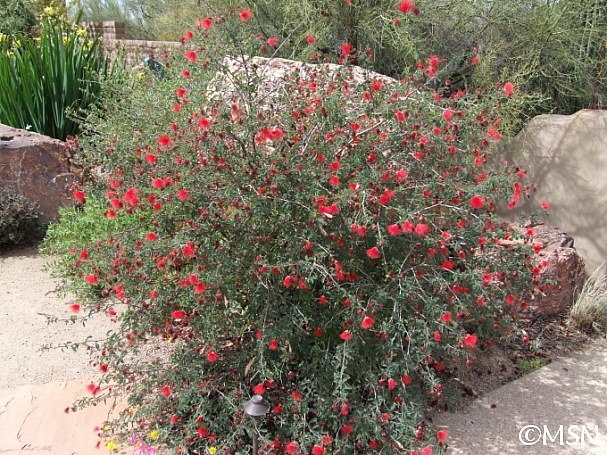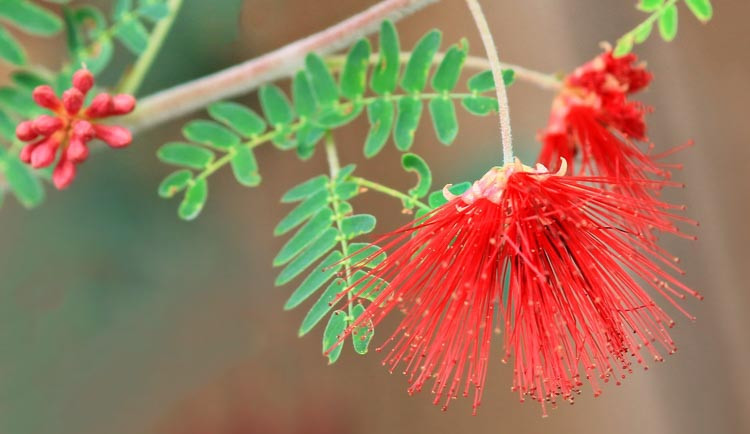Calliandra californica

Calliandra californica, commonly known as California Fairy Duster, is an enchanting flowering shrub native to the southwestern United States and northern Mexico.
Admired for its delicate pink powder-puff flowers, feathery foliage, and drought tolerance, California Fairy Duster adds charm and color to arid landscapes.
In this comprehensive article, we will delve into the botanical intricacies, habitat preferences, life cycle, ecological and cultural importance, conservation status, and care guidelines for Calliandra californica.
Botanical Description
California Fairy Duster belongs to the Fabaceae family and is characterized by its low-growing, spreading habit, reaching a height of 2 to 4 feet and a similar spread.
The plant features finely divided, fern-like leaves that are gray-green in color and provide an airy backdrop for its striking flowers.
The flowers of California Fairy Duster are its most captivating feature, resembling fluffy pink powder puffs or miniature bottlebrushes.
These showy flowers appear in clusters at the tips of the branches. They bloom profusely from late spring through summer, attracting a variety of pollinators, including bees, butterflies, and hummingbirds.
After flowering, California Fairy Duster may produce small seed pods containing seeds that are dispersed by animals or wind.
Habitat and Distribution
California Fairy Duster is native to dry, sandy, or rocky habitats, including desert washes, arroyos, desert scrub, and chaparral. It thrives in well-drained soils and full sunlight.
California Fairy Duster thrives throughout the southwestern United States, spanning California, Arizona, Nevada, New Mexico, and Texas.
Gardeners often use it in xeriscaping and water-wise landscaping projects to add color and texture to drought-tolerant gardens.
Life Cycle and Phenology
As a perennial shrub, California Fairy Duster follows a typical life cycle for woody plants in arid environments.
Growth occurs primarily in spring and summer, with new leaves and flowers emerging from dormant buds in response to warming temperatures and increasing daylight.
Flowering typically occurs from late spring through summer, depending on local climate conditions, with peak bloom coinciding with the onset of the summer monsoon season in some areas.
Bees and other insects primarily carry out pollination as they are attracted to the flowers' nectar and pollen.
After flowering, California Fairy Duster may produce seed pods, which mature and split open to release the seeds for dispersal.

Caring for Calliandra californica
Sunlight
Plant California Fairy Duster in a location that receives full sunlight, as it requires abundant sunlight for optimal growth and flowering.
Watering
Once established, California Fairy Duster demonstrates drought tolerance and requires minimal irrigation. Therefore, water sparingly, especially during the establishment phase, to promote deep root growth and improve drought resilience.
Soil
Plant in well-drained, sandy or rocky soil with good drainage.
Avoid heavy clay soils, as they can cause root rot and other problems.
Pruning
California Fairy Duster requires minimal pruning to maintain its shape and remove dead or damaged growth.
Prune lightly after flowering to promote bushy growth and encourage more blooms.
Fertilizing
California Fairy Duster is not a heavy feeder and typically does not need fertilization. If desired, apply a balanced fertilizer in spring, following the manufacturer's instructions.
Mulching
Applying a layer of organic mulch around the base of the plant helps retain moisture.
Additionally, it suppresses weeds and insulates the roots from temperature fluctuations.
By adhering to these care instructions, you can nurture robust California Fairy Duster shrubs, enriching arid landscapes and preserving native plants. Whether for decoration, ecology, or culture, its charm persists.
a q h
Leave a Reply
You must be logged in to post a comment.